Emily Lakdawalla • Mar 05, 2014
2015 will be the Year of the Dwarf Planet, and you need to tell people about it!
I am very excited about 2015, more so than I have been about any year since I started working at The Planetary Society. There have been many things to get excited about in previous years, but 2015 will be extra special because two missions will turn three dots in the sky into geographical worlds. I'm talking about Dawn, which will enter orbit at Ceres, and New Horizons, which will fly past Pluto and Charon.
In my professional career, I've seen lots of dots turn into lumpy worlds: Phoebe, Itokawa, Tempel 1, and Lutetia, to name a few. They're all exciting, and quite surprisingly diverse, but their surfaces largely record external influences: they're battered by craters and reddened by space weathering and mostly bear witness to harms they experienced from outside. As a geologist, I'm attracted to places where internal fires fueled geologic activity, whose surfaces record a story written from the inside. And the last time we saw one of those kinds of places for the first time ever was in 1989, when Voyager 2 found Triton to be utterly different from any moon we'd seen before.
A good signpost suggesting which worlds have likely experienced internal geology and which ones haven't is whether the world is round. If a world is round, that means it's massive enough for the force imposed by its self-gravity to overcome the strength of its component materials, reshaping it. How big you have to be to get round depends upon your internal composition; it seems to be above 600 kilometers (at least) for rocky worlds, but only 400 kilometers for icy ones. Pluto (2330 km), Ceres (990 km), and Charon (1207 km) are all big enough to be round. As of this time next year, we'll be getting our very first views of three round worlds, turning them into places with geography and geology for us to explore.
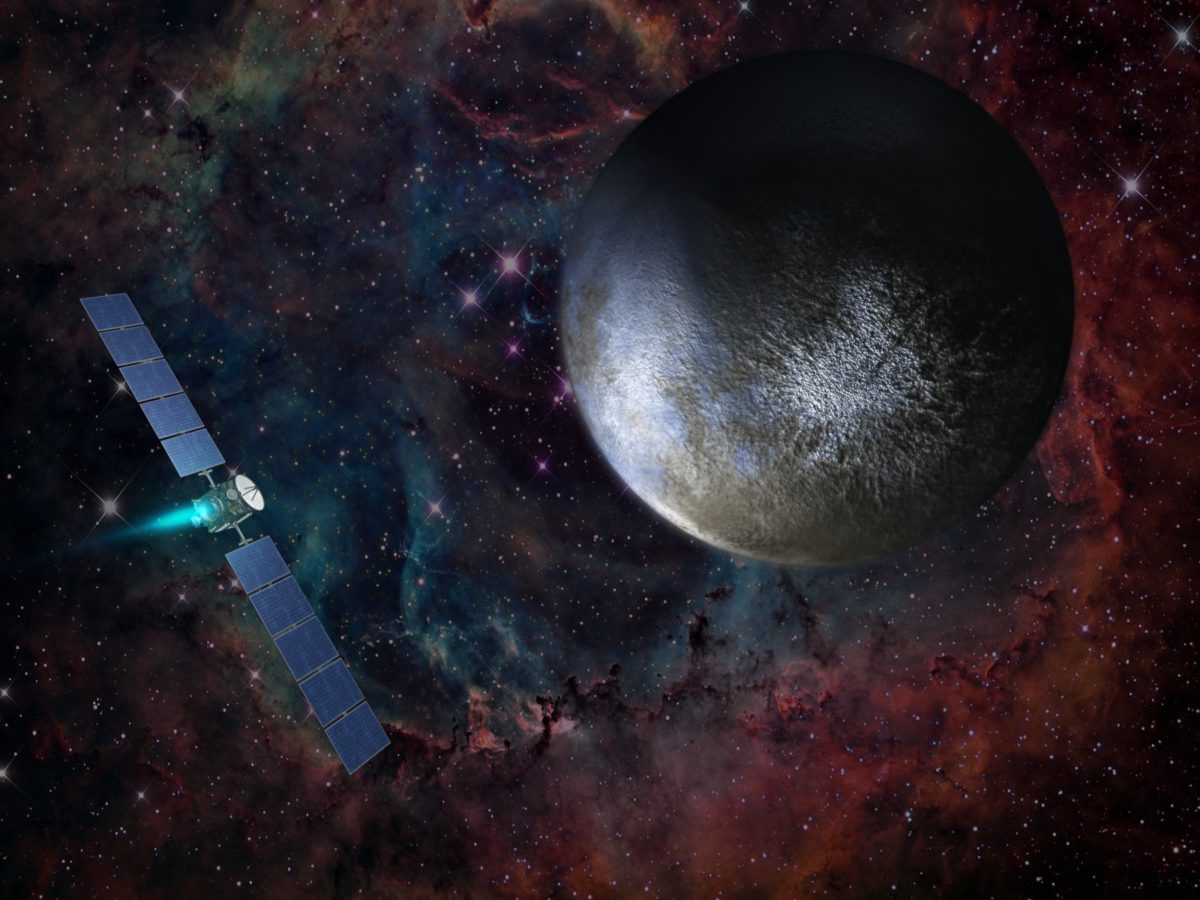
I know that many of you reading this blog probably feel as excited about Pluto, Charon, and Ceres as I do. And there's no doubt that Pluto remains a popular topic among adults. But, as a parent of a child born three weeks before Pluto's "demotion", I've seen how its nomenclature change has resulted in its astonishingly rapid redaction from educational products. School teachers -- who don't receive much science training, at least in the U.S. -- mostly don't seem to understand what Pluto is now thought to be; I've had several teachers ask me if Pluto is now considered some kind of star. Beyond Pluto, most teachers, kids, and parents definitely don't know what Charon and Ceres are, if they've heard of them at all.
This lack of understanding is a serious problem for those of us who are fans of NASA's planetary exploration program, because it's very hard to talk people into funding a space program whose destinations seem to be places nobody ever heard of. Ceres, Pluto, Charon; and I'll add Europa, Ganymede, Titan, Enceladus, and Triton: how important can they be, if they're not on that list of eight planets? You want how much money? To fly a spacecraft to where, exactly? Enchiladas?
And it doesn't look like NASA is planning to help much with this perception problem. In a slide extolling "Anticipated Accomplishments in Fiscal Year 2015" included in their presentation of the 2015 budget yesterday, they mentioned such exciting things as "Asteroid Redirect Mission: Hold Concept Review" but not the anticipated accomplishments of flying by Pluto for the first time, or entering orbit around the largest asteroid and only dwarf planet in the asteroid belt, together getting our first views of two worlds that will be totally different from anything we've ever explored before.
We could wring our hands about all of this and say "Oh, public education is so terrible, people are idiots, NASA neglects planetary science, blah blah blah," but that's not constructive and it's not my style. I'm totally with Randall Munroe on this:
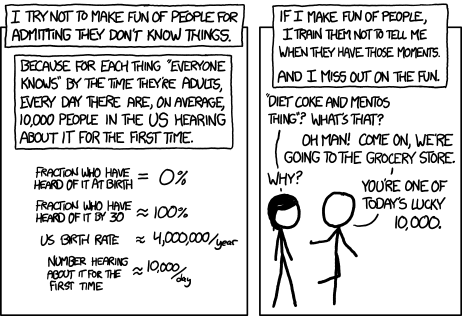
Instead, I'm calling on you, dear readers, to start spreading the word about how awesome 2015 is going to be. How we're boldly going where no one has gone before. That in February or March of 2015, three tiny dots will start growing into disks on the main viewer of two of our ships -- except it's better than that; it's not just a privileged ship's crew that will be seeing these dots grow into worlds, it's all of us, everyone on Earth, because they'll be sharing their photos on the Internet, where everyone can see them, and wonder at them, and share them, and talk about them with each other.
We've completed the initial reconnaissance of the planets; we've seen them all for the first time, and followed up by sending orbital missions to most of them (with the notable exceptions of Neptune and Uranus, because they're so distant). We've moved into a new phase of planetary exploration, where we focus in on those worlds whose stories are most compelling to us. While some of those worlds considered most worthy of further followup are planets, many of them are not. They are large moons, like Europa, Ganymede, Titan, Enceladus, and Triton; or they're dwarf planets, like Pluto and Ceres.
I thought I'd make a few graphics to help people tell this story. Here are all the round worlds in the solar system that we've visited with spacecraft that are smaller than 10,000 kilometers in diameter. "Round" is, of course, relative; there's a couple of worlds at the bottom end of the graphic that are maybe a little lumpy. I'm never quite sure what to do with Proteus. And Vesta is really not round, but it's bigger than some of the definitely-round moons and may have had some internal geologic activity, so I left it on the list. It's a cool borderline case, anyway. And then there's Mars and Mercury: I love including planets on graphics like these. When you include the planets it's striking and surprising how big and varied the solar system's large moons are; they're quite planet-like, and you'll often hear planetary scientists slip up and call them "planets" when they're discussing geology of the planet-sized moons. (Some call them "planets" intentionally.) If you're wondering about the uneven spacing of the worlds, just wait.
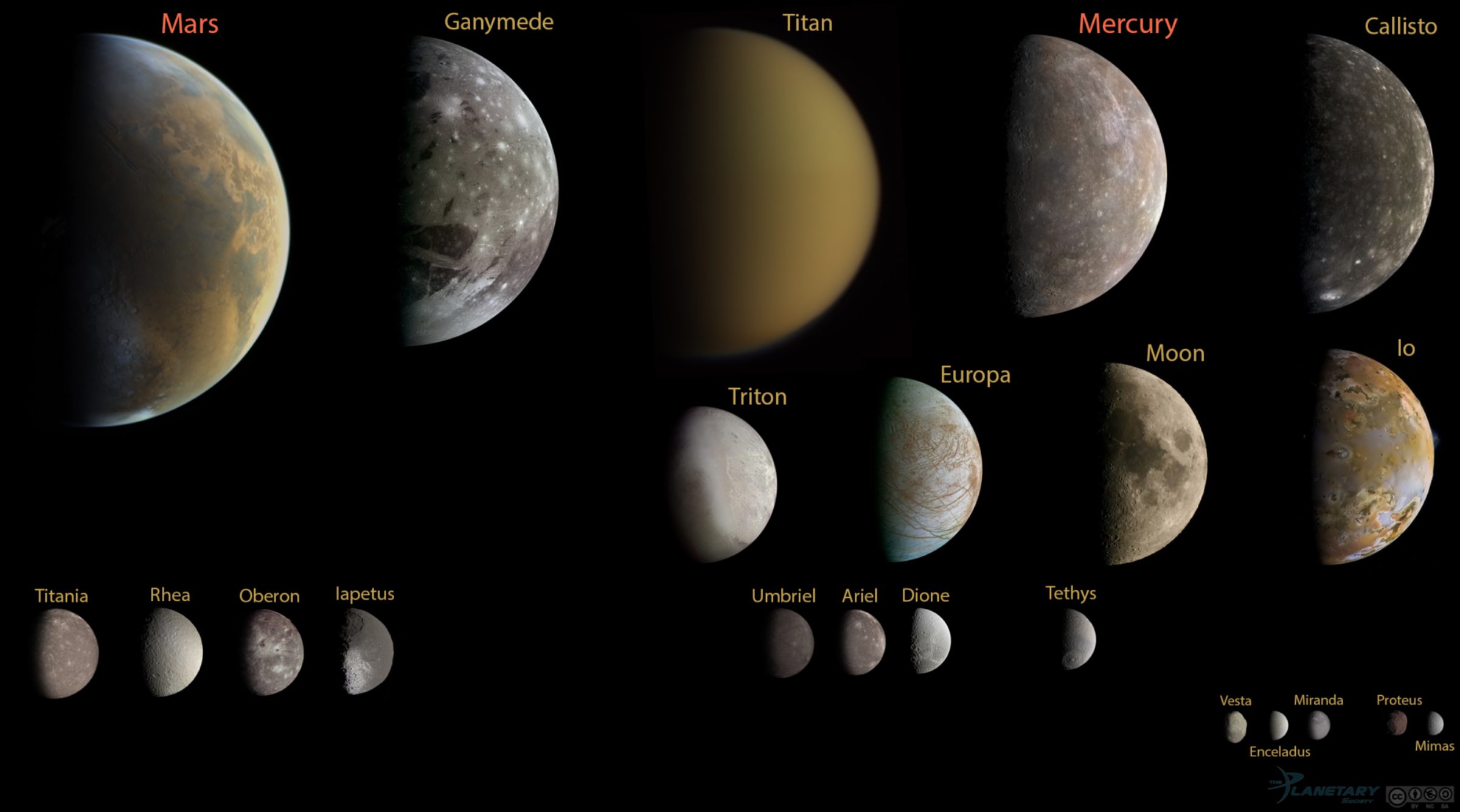
OK, now I'm adding in half-circles scaled to the sizes of the biggest asteroids we haven't visited: Ceres, Pallas, and Hygeia; as well as Pluto and Charon. Pluto is in an interesting position in the lineup -- smaller than the planet-sized moons, larger than the mid-sized iceball moons. Will Pluto look more planet-ish or more moon-ish? We won't know until next year! Charon, on the other hand, sits comfortably among the lineup of iceball moons, and I'm guessing it'll resemble its cousins at Saturn and Uranus, but again: who knows? Ceres is probably big enough to be pretty much round; we've gotten a good enough look from Hubble to know that it's pretty round. Pallas and Hygeia probably aren't round, like Vesta. The next biggest asteroids (Interamnia, Europa, Davida, and Sylvia) are substantially smaller than anything else on this graphic. The biggest Centaurs and Trojans are even smaller than that.
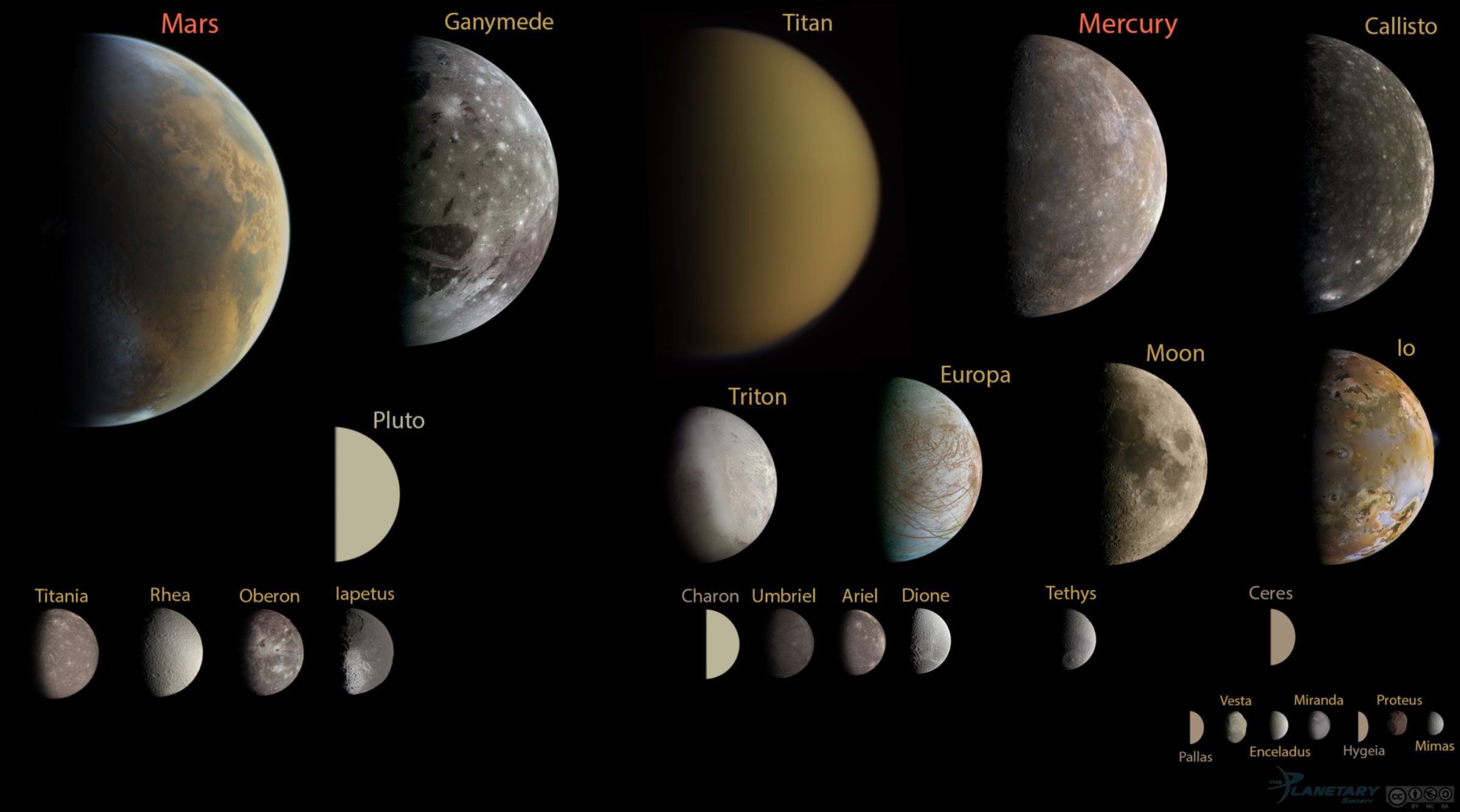
But the lineup above doesn't tell the full story. The reason Pluto was demoted was because we discovered other worlds out there that form a whole population of bodies, analagous to the asteroid belt, that occupy the same region of space. But we never talk about these other worlds. That's natural, because we don't know a lot about them; but the focus on Pluto tends to make us dismiss the rest as another belt of lumpy cratered rocks.
The Kuiper belt isn't like that at all. Unlike the asteroid belt -- which may contain only one round object -- the space beyond Neptune is absolutely full of large round worlds; Pluto is only the beginning. There's one other world as big as Pluto -- Eris -- and probably another eight that fit in with Charon in the company of the definitely-round, mid-sized, 1000-kilometer-ish iceballs. A further 70 or so objects fill in the size distribution from the Tethys-sized Salacia to the Proteus-sized 1999 TC36. Of course, they're so far away that we often have trouble being sure just how big they are, and size estimates will change over time; but the population of bodies is large enough that the numbers should hold up pretty well, even as estimates for the sizes of individual objects shift up and down. (The sizes I display on this diagram came from Mike Brown's website.)
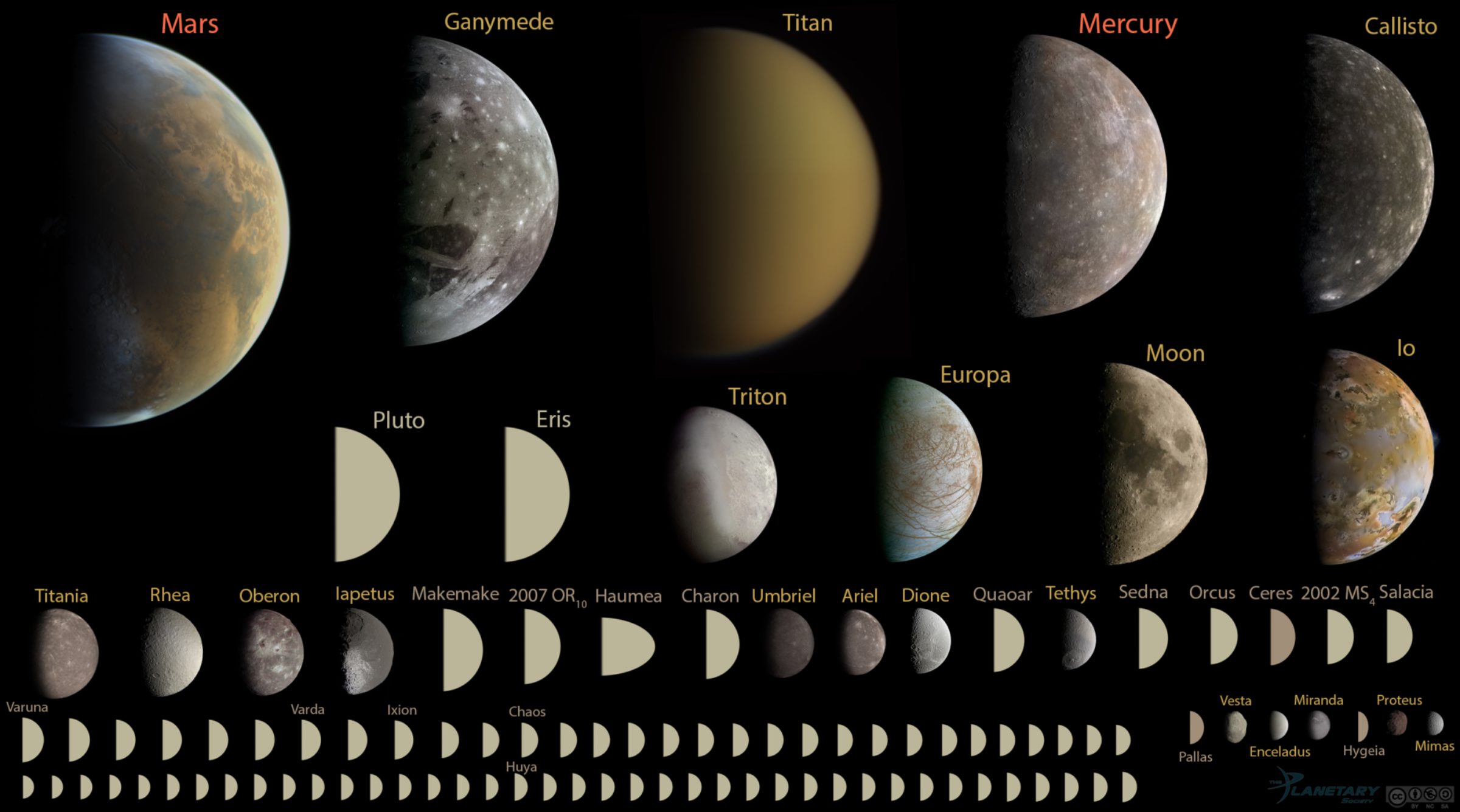
Just look at all of these worlds, and think about how much of the solar system we have yet to explore. Think about how much we have to learn by orbiting, and maybe even landing on, those planet-sized moons. Think about how Pluto isn't the end of the planets, it's the start of a whole new part of the solar system that we've never seen before, and how seeing Charon is going to clue us in to what's happening on a dozen other similar-sized, unvisitably far worlds.
That's why 2015 is going to be so exciting. This is probably just the first of many posts on how to excite and educate people about 2015. Now, space fans, go out and tell people about the places that aren't planets that we have yet to explore.
Let’s Go Beyond The Horizon
Every success in space exploration is the result of the community of space enthusiasts, like you, who believe it is important. You can help usher in the next great era of space exploration with your gift today.
Donate Today

 Explore Worlds
Explore Worlds Find Life
Find Life Defend Earth
Defend Earth


